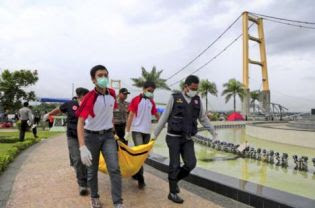Jakarta Globe, Christiane Oelrich, January 01, 2012
 |
A man perches on a makeshift raft on a river covered with trash as he
searches for materials to recycle, north of Indonesia's capital, Jakarta
in this file photo. Residents in Tangerang are taking trash collection into
their own hands. (Reuters Photo/Supri)
|
Related
articles
Tangerang.
Crouched and concentrated, August and Karma rip open knotted plastic bags at
the foot of a big pile of rubbish.
Yoghurt
cups, paper packaging, plastic, pineapple rinds, cabbage leaves, chicken bones
and the like fall out. The young Indonesian men begin sorting. Organic material
goes to one side, and bottles, plastic and paper to the other.
“A super
job,” remarks Karma, 23. “Finally, reliable work.” The two sort their rubbish
and that of their neighbors, too. For the past year, the 325 families in Griya
Serpong — a working class housing area of Tangerang, a city some 40 kilometers
south-west of Jakarta — have been disposing of their garbage themselves.
Municipal
garbage collection was never reliable, and the residents used to dump their
refuse in a vacant field — a paradise for rats, flies, mosquitoes and snakes.
Everything
is different now. The roofed garbage sorting facility is a source of local
pride.
“It’s got a
lot cleaner here,” notes Ulil Albab, the project’s honorary chairman.
“Nobody
wanted to have anything to do with rubbish before. Now we bring school kids
here and show them how to compost,” Karma says.
Residents
built the facility with the help of BEST, a local non-governmental organization
focusing on urban poverty and community development, and BORDA (Bremen Overseas
Research and Development Association), a German non-profit organization that
aims to improve the living conditions of disadvantaged communities and to keep
the environment intact.
At a
monthly cost per family of 12,000 Indonesian rupiahs, or a little over 1
dollar, August and Karma sweep through the alleyways of Griya Serpong with
their moped and trailer every day collecting garbage — 400 kilograms of it.
They
compost all organic refuse at the sorting facility. It is then sold along with
the plastic, glass and paper.
Agathe, 35,
has made a business out of rubbish. She collects discarded detergent and noodle
bags. She and her girlfriends fashion colorful handbags and wallets from them.
When
everything of value has been separated out of the housing area’s refuse, no
more than 30 percent remains. It is taken to a tip.
BEST
Director Hamzah Harun Al Rasyid is pleased. “It’s a win-win situation,” he
says. “The housing area is cleaner, there are new jobs, and there is
considerably less rubbish, so we’re reducing methane emissions from the garbage
tips.”
Karma and
August constantly turn over the compost pile, which aerates it. This helps
prevent the formation of methane, a potent greenhouse gas that makes garbage
tips a big contributor to global warming.
As
Indonesia’s population grows rapidly, so do the piles of garbage that are
produced by the country’s more than 240 million inhabitants.
While
recycling is a booming industry — for example in Germany, where it generates
some 67 billion dollars in revenues annually — almost all of the Indonesian
garbage is incinerated or dumped in open tips.
About 1.8
million tons of garbage is likely to be produced daily worldwide by 2025,
according to BORDA. In Indonesia, 62 percent of the refuse is organic and could
be composted. But there is no large-scale sorting of refuse.
Facilities
like the one in Griya Serpong are catching on. The twenty-first one is to be
inaugurated in the near future, and many other communities are clamoring for
their own.
“We
estimate that each facility like this reduces methane by 132 tons a year,” said
Jati Kusumowati, who works at the BORDA office in the city of Yogyakarta. “We
think they ought to be promoted internationally as well.” One way to do this
might be via the Clean Development Mechanism (CDM) set out in the Kyoto
Protocol on climate change, which allows industrialized countries to meet their
emission--reduction or limitation commitments in part by paying for emission
cuts in developing countries.
A one-ton
reduction in methane would earn about 13 to 16 dollars, according to
Kusumowati.
But small
projects such as the one in Griya Serpong would not clear the technical and
bureaucratic hurdles necessary for them to be officially recognized. BORDA is
now trying to get the requirements for small projects loosened.
DPA






